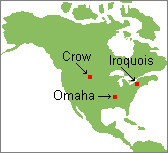Kin
Naming Systems: Part 2
The remaining kin terminological systems are named after three North
American Indian cultures that used them: Omaha
 , Crow
, Crow
 , and Iroquois
, and Iroquois
 .
The fact that these naming systems are strikingly different from each other is a reminder
that there was considerable cultural diversity among the original inhabitants of the
western hemisphere.
.
The fact that these naming systems are strikingly different from each other is a reminder
that there was considerable cultural diversity among the original inhabitants of the
western hemisphere.
In order to comprehend the
Omaha, Crow, and Iroquois naming systems, it is important to first understand a common
distinction made between types of cousins in societies following unilineal descent.
For the majority of people in
contemporary Europe and the Americas whose cultures use the
bilateral
descent principle, these cousin
differences seem to be irrelevant and unnecessary. However, they are logical and
easy to understand when viewed in their cultural context.
Parallel cousins are ego's father's
brother's children and mother's sister's children. In contrast,
cross cousins
are ego's father's sister's children and mother's brother's children. In other
words, there is a crossing of gender in the parent generation with cross cousins but not
with parallel ones. The gender of the cousin is not relevant in making this
distinction.

The importance of this
categorization of cousins can be understood in terms of descent relationships. Note
that in the red patrilineage shown below, parallel cousins are members of ego's unilineage, while cross cousins are not.

The same is true with
matrilineages--only parallel cousins are relatives. These distinctions can be
critical in determining who an individual may and may not marry and with whom there is
likely to be mutual assistance obligations.

Omaha
System
The Omaha kin naming
system is characteristic of societies that use patrilineal descent. Relatives
are lumped together on the basis of descent and gender. Siblings and parallel
cousins of the same gender are given the same term of reference (5 = males and 6 =
females). Father and father's brothers also have the same kin term (1).

Other people in ego's
mother's patrilineage are lumped across generations (2 = female and 4 = male).
This reflects the comparative unimportance of the mother's side of the family in a society
that strongly follows the patrilineal descent principle.

Crow
System
An almost mirror image of
the Omaha pattern is the matrilineally based Crow kin naming system.
Relatives are also lumped together on the basis of descent and gender. Siblings and
parallel cousins of the same gender are given the same term of reference (5 = male and 6 =
female). Mother and mother's sister also have the same kin term (2).

Other people in ego's
father's matrilineage are lumped across generations (1 = male and 3 =
female). This reflects the comparative unimportance of the father's side of the
family in a society that strongly follows the matrilineal principle of descent.

Differences between the
Omaha and Crow systems can be seen in the terms of reference for cross cousins and whether
or not uncles and aunts are lumped with them. These differences stem from the fact
that the Omaha system is patrilineal and the Crow is matrilineal.
Compare the two kin naming systems and note the similarities and differences.
Omaha
system |
|
 |
|
|
Crow
system |
|
 |
Iroquois
System
In the Iroquois kin
naming system, the same term of reference is used for father and father's brother (1)
as well as mother and mother's sister (2). This merging is related to shared
membership in unilineages, as it is in the Omaha and Crow systems. However, the
Iroquois system may be either patrilineal or matrilineal and is usually not as strongly
one or the other.

Also like the Omaha and Crow
patterns, the Iroquois system lumps together parallel cousins from both sides of
the family with siblings but distinguishes them by gender (5 = male and 6 = female).
What sets the Iroquois system apart is the fact that cross cousins are also lumped
together and distinguished by gender (7 = male and 8 = female). The reason is that
there usually is a preference for marriage to cross cousins
in societies that use the Iroquois system.

Summary
There are six distinct kin naming systems used
around the world. They
are referred to as the
Eskimo,
Hawaiian,
Sudanese,
Omaha,
Crow,
and
Iroquois
systems. Keep in mind that they are not
limited to the cultures for which they were named. It is also important to
understand that these systems are seldom followed exactly--they usually have unique
cultural variations.
Kin naming systems are
complex and confusing for most students. If you are still not clear on how they
work, it would be a good idea to go over them again.
This page was last updated on
Wednesday, June 28, 2006.
Copyright © 1997-2006 by Dennis O'Neil.
All rights reserved.
Illustration credits

![]() , Crow
, Crow
![]() , and Iroquois
, and Iroquois
![]() .
The fact that these naming systems are strikingly different from each other is a reminder
that there was considerable cultural diversity among the original inhabitants of the
western hemisphere.
.
The fact that these naming systems are strikingly different from each other is a reminder
that there was considerable cultural diversity among the original inhabitants of the
western hemisphere.







